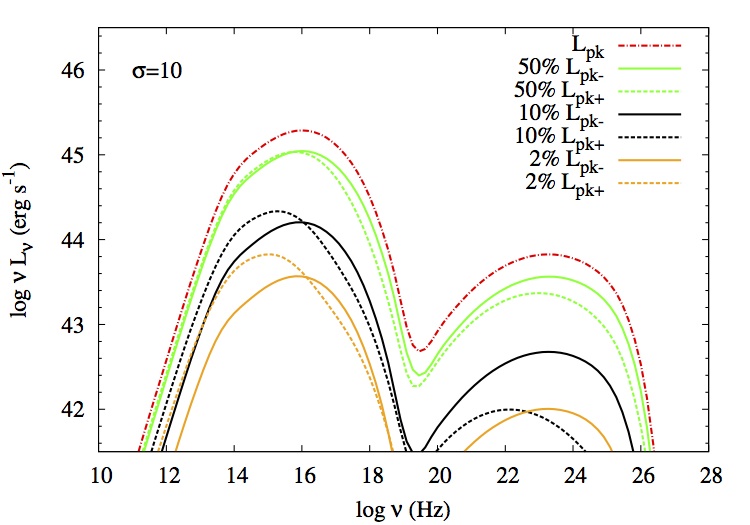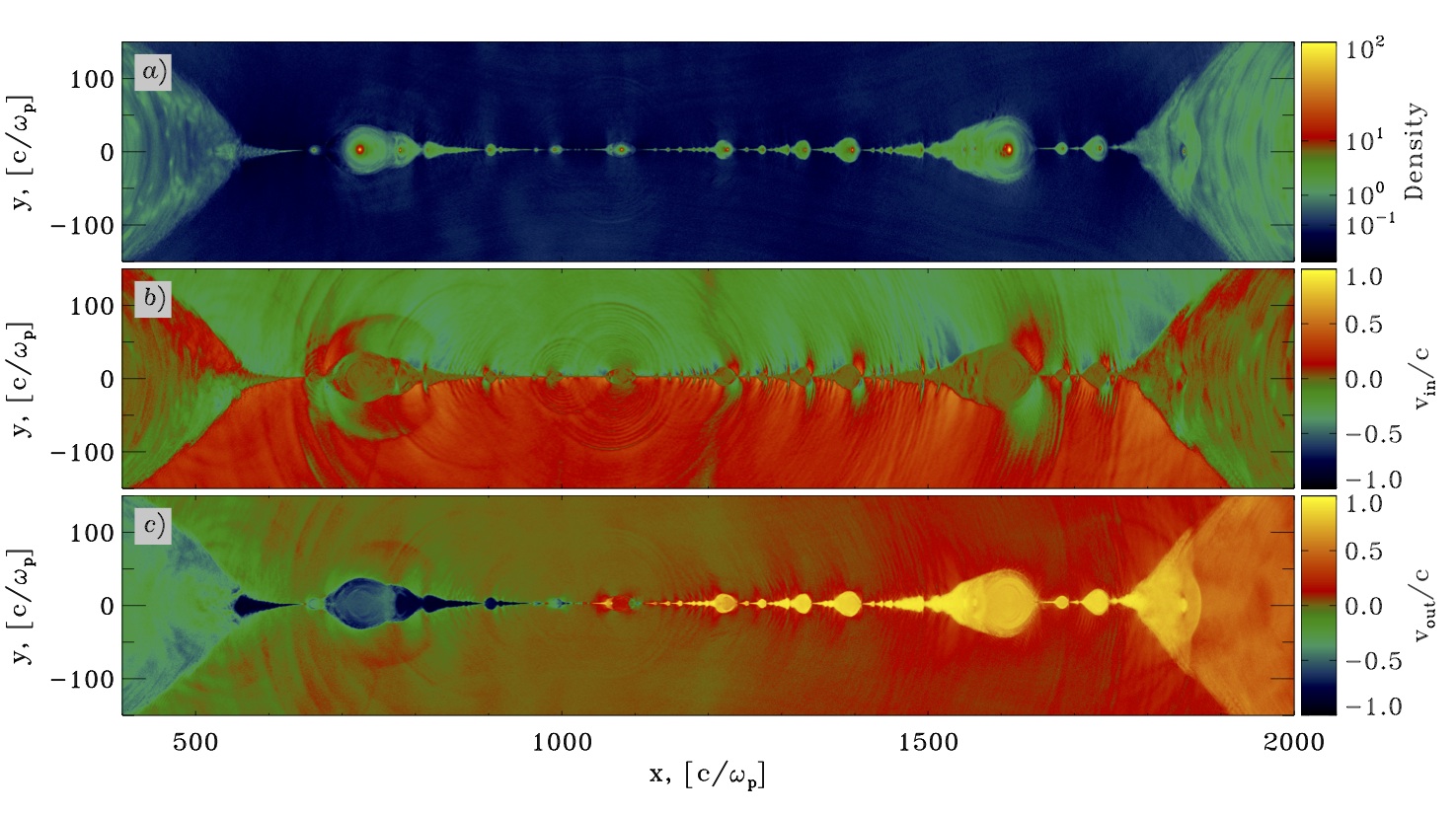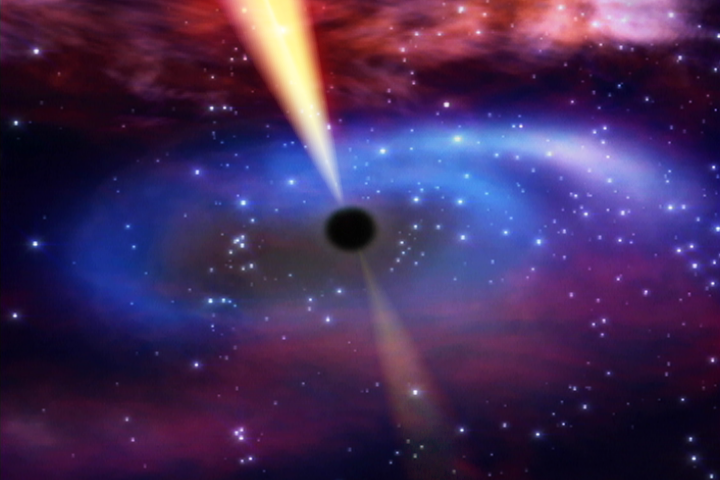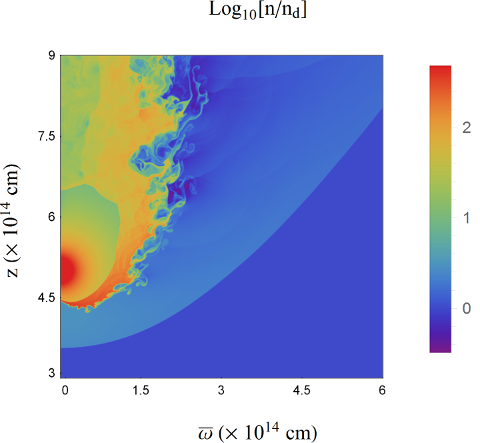Research
Our research is in the field of theoretical Astrophysics with focus on high-energy astrophysical phenomena and gravitation physics. We are particularly interested in the fate of the energy released when plasma is fed into black holes, and in powerful cosmic explosions.
Black holes offer a unique laboratory to study physics processes to their extreme. The gravitational energy liberated when gas falls into a black hole leads to spectacular electromagnetic displays. Gas is heated to millions or billions of degrees, beams of plasma are ejected at a speed close to that of light (relativistic jets) while particles are accelerated to the most extreme energies ever observed on Earth (ultra-high-energy cosmic rays). To study these sources, we apply general relativity, plasma physics, hydrodynamics of magnetized fluids, and radiative transfer.
Fast Beams of Plasma — Relativistic Astrophysical Jets

3D structure of magnetic field in the jet; credit: Barniol Duran, Tchekhovskoy
Relativistic jets emerge from super-massive black holes at the center of galaxies (blazars), outshining the host galaxy. Jets also accompany gamma-ray bursts, the brightest explosions in the universe, marking the birth of a black hole or a neutron star. We focus on the mechanisms responsible for the launching, acceleration and the spectacular emission of electromagnetic radiation observed from these sources.
Gamma-ray bursts have been observed for half a century. They have a very characteristic emission spectrum that has defied theoretical explanation. The radiative transfer calculations of Giannios pioneered the idea that the gamma-ray-burst emission can be understood as result of dissipation of magnetic energy via the process of magnetic reconnection. In particular, these studies identify that the burst photons are created deep in the jet and escape when it becomes transparent. Electron scattering is the key process for shaping the spectrum.

Spectrum of electromagnetic radiation from a reconnection blob; credit Petropoulou

Magnetic reconnection region filled with plasma blobs; credit Sironi
Magnetic reconnection may aslo power the observed radiation from blazar jets. Researchers in the field have long advocated that blobs containing relativistic electrons and magnetic fields are responsible for the, extremely powerful, blazar flares. Our work provides a physical model for the origin of these blobs. Giannios estimated that plasmoids that form at the reconnection layer could explain the energetics and timescales of the observed flares. First-principle simulations of the plasma physics of magnetic reconnections now validate this picture. Our work indicates that reconnection regions in jets are promising locations for the acceleration of cosmic-rays to energies as large as 108erg. Recently, we have applied these models to connect gamma-ray burst with the onset of the afterglow emission (see next paragraph).
The gamma-ray burst afterglow emission
The jet responsible for the gamma-ray burst collides with surrounding gas powering a, long-lasting, "afterglow" emission. Both the very early and late stages of the afterglow are very important in understanding gamma-ray bursts. The initial stages of the interaction of the jet with the external medium carry crucial information about the strength of the magnetic field in the jet. The emission decades after the burst can be used to probe particle acceleration in trans-relativistic shocks, the properties of the accompanying supernova or whether a neutron star is responsible for the burst.
A star is torn; a jet is born

A star is disrupted by a black hole and launches jets; credit ESA
Our research has played a significant role in the prediction and subsequent discovery of a novel type of powerful transients. The tidal disruption of a star by a supermassive black hole provides us with a rare glimpse of otherwise dormant supermassive black holes. A star that approaches too close to the black hole is torn apart and the stellar debris feed the black hole. Part of the released energy is channeled into a relativistic jet that makes a bright display: the first-time-ever detected “transient blazar” in a galactic center.
High-energy neutrinos
Neutrinos are weakly interacting particles that travel through the intergalactic medium almost unaffected by the intervening matter. Recently the IceCube collaboration announced the first-ever detection of PeV (1015 eV) neutrinos of astrophysicall origin. Blazars and gamma-ray burst have been suggested as candidate sources of PeV neutrinos long before their discovery. Our group focuses on the physics related to the neutrino production in relativistic jets from blazars and gamma-ray bursts and on the connection between the neutrino and photon emission.

Stellar wind interactions at the Galactic center; credit Christie, Petropoulou, Mimica
Our Galactic center
A behemoth black hole lies in our Galactic center. Despite its size, it is a faint source because it is under-fed with gas. It makes an excellent target to study how gas flows into black holes at very low rates. Recently, we have proposed that the stars and pulsars present in the Galactic center region can be used to probe the black-hole environment. Because of their extreme speeds, the stars are expected to undergo strong and bright interactions with the gas that flows towards the black hole.
Gravitation physics
Giannios group has also been interested in the structure of compact objects in different theories of gravity. While modifications to general relativity (GR) have been proposed to solve cosmological problems (e.g. that of dark matter), these theories make different predictions to GR in the strong gravity regime as well. As a case study, we have studied the appearance of black holes and neutron stars in modified gravity.